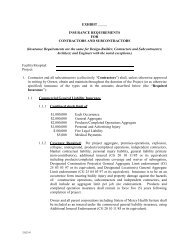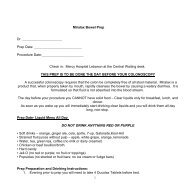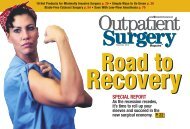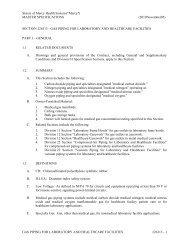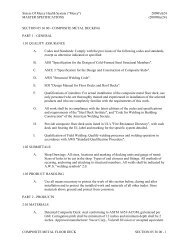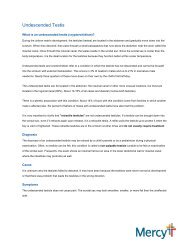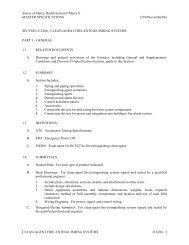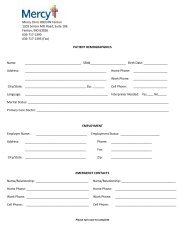Food Choices - Mercy
Food Choices - Mercy
Food Choices - Mercy
You also want an ePaper? Increase the reach of your titles
YUMPU automatically turns print PDFs into web optimized ePapers that Google loves.
SODIUMSodium is naturally present in the foods weeat and water we drink. This amount easilymeets the needs of most people. U. S.Dietary Guidelines recommend 2400mg sodium per day. Adult Americanintakes range from 3000-15,000 mgsodium per day. Sources of sodiumare: (1) table salt, (2) foods to which salt orsodium compounds have been added,(3) foods that naturally contain sodium,(4) chemically softened water that containssodium salts, and (5) some medications.Excessive sodium intake can aggravateexisting high blood pressure, a major riskfactor for heart disease. Individuals withhigh blood pressure or a family history ofany heart disease may benefit from reducingtheir sodium intake. Many doctors believethat everyone would be healthier if lesssodium were used.Salt is composed of 40 percent sodium and60 percent chloride. One-quarter teaspoonof salt contains 600 mg. sodium. Peopleacquire a taste for salty foods, and overtime this preference can be changed.TO LOWER YOUR SODIUM INTAKE:• Learn to enjoy foods without adding salt.Some persons salt food heavily withouteven tasting it first, and develop a tastefor high salt levels. Herbs and spices canbe used to add zip to foods, such asgarlic, onion, or chili powder, hot sauce,dill weed, lemon juice, flavored vinegarsand herb/spice blends. Use garlic or onionpowder instead of garlic or onion salt.• Eat more fresh and frozen fruits andvegetables. They contain very littlesodium.2400 mgsodiumper day• Limit foods highest in sodium: cannedvegetables, processed and conveniencefoods, canned and powdered soups, fastfoods, cheese, salty snacks, ham, bacon,sausage, frozen dinners, any foodspreserved in brine such as pickles, olivesand soy sauce.• Watch labels for hidden sodium, such asbaking powder, baking soda, MSG(monosodium glutamate--Accent), brine, orany chemical name that has sodium(sodium sulfite, sodium saccharin, etc.)• Be aware of other sodium sources such aschemical water softeners, chewingtobacco, carbonated drinks, and somemedicines.FATThere is increasing evidence that the typicalAmerican diet, which derives 35% - 40% ofits calories from fat, is unhealthy. A diet richin animal fats and cholesterol is stronglyrelated to a high risk of atherosclerosis andheart disease which may lead to a build upof plaque in the arteries and/or heart attack.30%or lessTo reduce this risk, scientistsrecommend a "Heart Healthy" low fatdiet. This means the total fat intakeis limited to 30% or less of the dailycalorie intake.DIETARY FAT COMES IN FOUR FORMS:Saturated, “Trans-fats”, Polyunsaturated,and Mono-unsaturated.SATURATED fat raises blood cholesterolmore than anything else in your diet.Saturated fat is found primarily in animalproducts - butter, whole milk, cream,PAGE 8POINTS FOR GOOD NUTRITION



